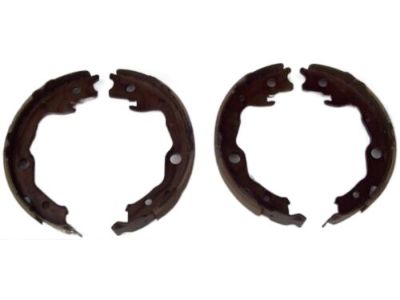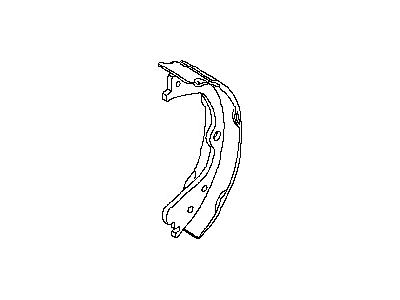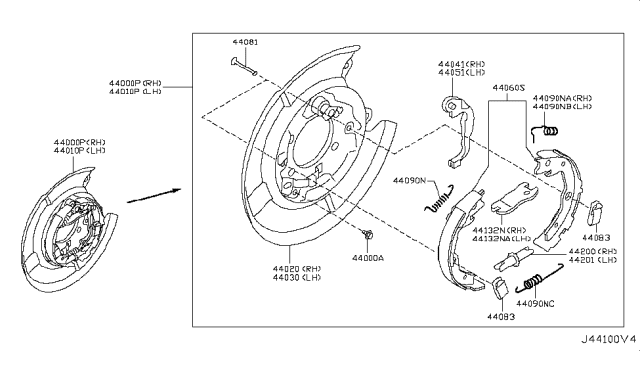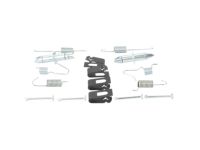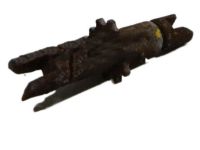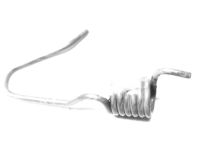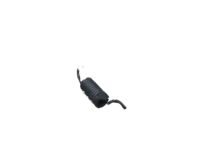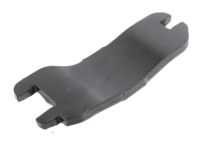Chock the front wheels, jack up the rear of the car, and support it on axle stands before removing the rear roadwheels and fully releasing the parking brake shoe. Unclip the plastic trim surrounding the parking brake lever from the top of the centre console to access the parking brake cable adjustment nut, measuring the length of thread protruding through the nut for refitting. Slacken the adjusting nut until it reaches the end of the thread without completely removing it, then remove the rear brake disc. Carefully remove all traces of brake dust from the brake drum, backplate, and shoes, measuring the thickness of the friction material at several points; if any shoe is worn to the specified minimum thickness or less, all four shoes must be renewed as a set, and renewal is also necessary if any are fouled with oil or grease. If any brake shoes are worn unevenly or contaminated, trace and rectify the cause before reassembly. Note the position of each shoe and the location of the return and adjuster springs, as well as the adjuster component locations to aid refitting. Using pliers, depress the shoe hold-down spring, turn the retaining pin through 90°, and lift off the shoe hold-down spring, repeating the procedure for the remaining brake shoe. Open up the lower ends of the brake shoes with long nose pliers to remove the adjuster strut, noting its fitted position, then release the upper return spring and withdraw the front brake shoe from the backplate, unhooking the lower adjuster spring. Release the upper return spring again to withdraw the strut plate from the rear brake shoe and parking brake lever, and when the rear shoe is withdrawn, release the parking brake lever from the brake shoe. If necessary, release the other end of the parking brake lever from the cable by pulling back the return spring. Check the condition of the forked end from the adjuster strut and examine the assembly for signs of wear or damage, paying particular attention to the threads and toothed adjuster wheel, renewing if necessary, and check all return springs, renewing any that show signs of distortion or damage. Clean the backplate and apply a thin smear of high-temperature brake grease or anti-seize compound to all surfaces of the backplate that bear on the shoes, ensuring the lubricant does not foul the friction material. If removed, refit the end of the parking brake lever to the cable by pulling back the return spring, then refit the parking brake lever back to the rear brake shoe and the upper return spring. Slide the strut plate back into position in the slot in the rear brake shoe and parking brake lever, locating the end of the spring in the hole in the strut plate, then refit the upper return spring to the front brake shoe and reconnect it to the upper mounting bracket, ensuring the upper strut plate is fitted into the slot in the front brake shoe. Refit the lower return spring to the lower part of the brake shoes, shorten the adjuster strut to its minimum length by turning the toothed wheel, and apply a smear of brake grease to the contact faces at each end of the adjuster strut. With the spring in place, open up the lower part of the brake shoes and slide the adjuster strut back into position, ensuring it is fitted the correct way around and that the ends are fitted to the slots in the brake shoes. Use a flat-bladed screwdriver to hold the retaining pins in position, then fit the two hold-down springs to both brake shoes, turning the retaining pins through 90° to secure the hold-down springs. Check that all components have been correctly refitted and that the adjuster mechanism operates correctly, then turn the adjuster strut toothed wheel to expand the shoes until the brake disc/drum just slides over the shoes. Refit the rear brake disc, repeat the procedure on the remaining rear brake, check and adjust the parking brake cable, refit the parking brake lever trim to the top of the centre console, and finally refit the roadwheels before lowering the vehicle to the ground.
Posted by NissanPartsDeal Specialist 

